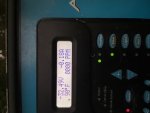My salt cell (Hayward turbo) is staying that chlorinator is off due to low salt. The diagnostic reading is attached. It is reading at 0000 ppm salt levels and negative power. I have A salt test kit and it is showing 3000 ppm so i know I’m ok there. I replaced The cell only a year ago. I pulled it out to clean it and it looked fine. I unplugged it and plugged it back in. Flow is on and seems good. Thoughts? Thanks.
Chlorinator -Off low salt test salt
- Thread starter Re Pool
- Start date
You are using an out of date browser. It may not display this or other websites correctly.
You should upgrade or use an alternative browser.
You should upgrade or use an alternative browser.
- May 3, 2014
- 59,732
- Pool Size
- 6000
- Surface
- Fiberglass
- Chlorine
- Salt Water Generator
- SWG Type
- Pentair Intellichlor IC-40
This is the basic information we need to know in diagnosing an problem:
- Report all readings when you..
- Move the switch from auto to off and check all of the readings.
- Move the switch back to auto and recheck the readings.
- Move the switch to off for a minute and then back to auto and recheck the readings.
- What are the first seven characters of the cell and box serial numbers?
- What is the actual salinity and how are you measuring it?
Go to the diagnostic screen and press the + button to reverse the polarity.
When the new numbers appear, see what they are.
Then, press + again and note the new readings.
When the new numbers appear, see what they are.
Then, press + again and note the new readings.
This is the basic information we need to know in diagnosing an problem:
- Report all readings when you..
- Move the switch from auto to off and check all of the readings.
- Move the switch back to auto and recheck the readings.
- Move the switch to off for a minute and then back to auto and recheck the readings.
- What are the first seven characters of the cell and box serial numbers?
- What is the actual salinity and how are you measuring it
- Report all readings when you..
- Move the switch from auto to off and check all of the readings.
- Move the switch back to auto and recheck the readings.
- Move the switch to off for a minute and then back to auto and recheck the readings.
- What are the first seven characters of the cell and box serial numbers?
[*]
- Report all readings when you..
- Move the switch from auto to off and check all of the readings.
- Move the switch back to auto and recheck the readings.
- Move the switch to off for a minute and then back to auto and recheck the readings.
- What are the first seven characters of the cell and box serial numbers?
- What is the actual salinity and how are you measuring it?
The information was for Aquarite.
Yours is a little bit different.
Do the reverse polarity test.
Check the yellow 20 amp fuse on the circuit board.
Check the back of the circuit board for a bad solder point and touch up as needed.
Yours is a little bit different.
Do the reverse polarity test.
Check the yellow 20 amp fuse on the circuit board.
Check the back of the circuit board for a bad solder point and touch up as needed.
Attached are the new readingsGo to the diagnostic screen and press the + button to reverse the polarity.
When the new numbers appear, see what they are.
Then, press + again and note the new readings.
Attachments
Looks like a bad cell or a bad circuit board.
You can have the cell tested at a pool store who has the cell tester.
If the cell is under warranty, and it's bad, they should give you a new cell.
Check the 20 amp yellow fuse and replace it if it's bad.
If a new fuse doesn't work, check the back of the circuit board for burn marks or a bad solder point and touch up the solder point as needed.
You can have the cell tested at a pool store who has the cell tester.
If the cell is under warranty, and it's bad, they should give you a new cell.
Check the 20 amp yellow fuse and replace it if it's bad.
If a new fuse doesn't work, check the back of the circuit board for burn marks or a bad solder point and touch up the solder point as needed.
Thanks, I will take it up to store tomorrow and see what they can doLooks like a bad cell or a bad circuit board.
You can have the cell tested at a pool store who has the cell tester.
If the cell is under warranty, and it's bad, they should give you a new cell.
Check the 20 amp yellow fuse and replace it if it's bad.
If a new fuse doesn't work, check the back of the circuit board for burn marks or a bad solder point and touch up the solder point as needed.
Thread Status
Hello , This thread has been inactive for over 60 days. New postings here are unlikely to be seen or responded to by other members. For better visibility, consider Starting A New Thread.



